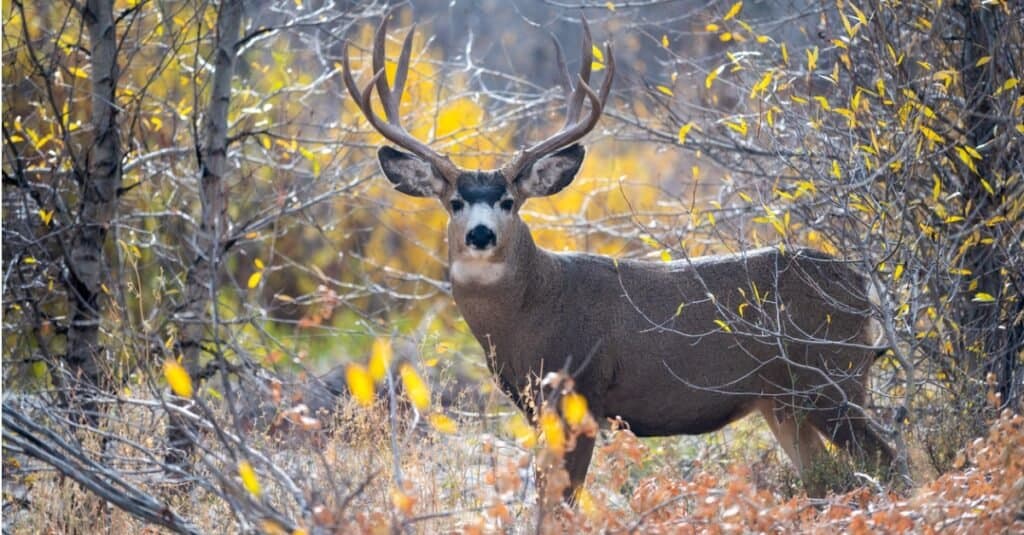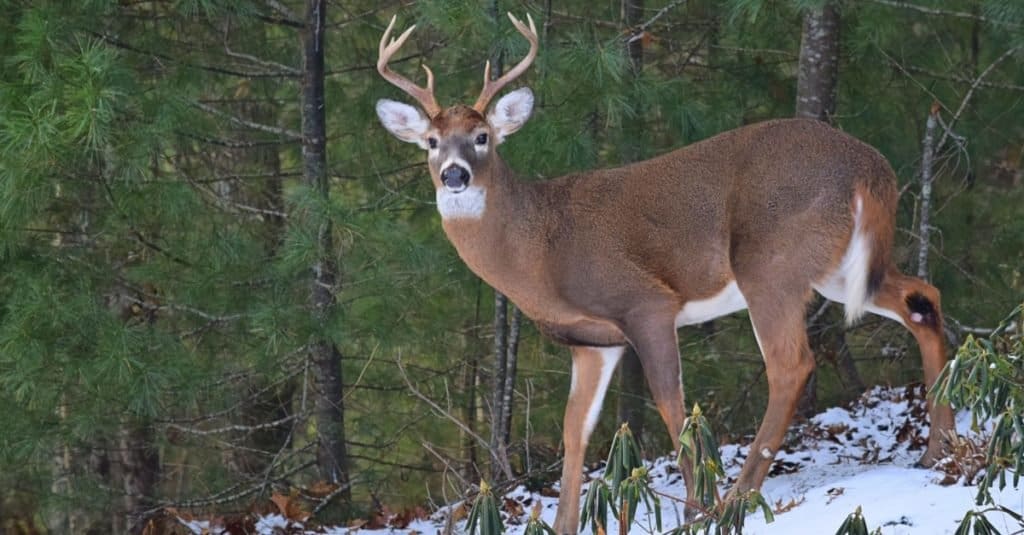Mule deer and white-tail deer are species of deer that are native to North America. Both species are known for their distinctive white patches which means that it’s quite easy to mistake the two, especially considering they share the same range and habitat. So, it is possible to tell them apart? The answer is yes! Despite their similarities, there are actually quite a few key differences between them.
For a start, their ears are significantly different, and their large ears are what give mule deer their name. But not only that, but they have completely different antlers, and even have a different style of running too! There’s plenty to learn about these stunning animals, so come and join us as we discover all of the differences between mule deer and white-tails.
Comparing White-tail vs Mule Deer
Mule deer and white-tails are both medium-sized deer that have unique markings. However, their distinctive white patches, particularly around their rump, can make them difficult to tell apart. Both species are also ruminants, which means that they have four stomachs. Ruminants regurgitate food to chew it over again – or “chew the cud” – just like cows and sheep. However, there are still a few differences that make mule deer and whitetails easy to distinguish once you know how!
Check out the chart below to learn a few of the main differences.
| White-tail | Mule Deer | |
| Size | Varies widely across their range with larger animals living further from the equator Bucks – 150 to 400+ pounds Does – 90 to 200 pounds | Bucks – 120 to 330 pounds Does – 100 to 220 pounds |
| Location | North America & South America Introduced to the Caribbean, Europe, and New Zealand | Western North America |
| Subspecies | 38 subspecies | 11 subspecies |
| Antlers | All tines grow from the main beam | Fork in two directions as they grow, tines then split and fork again |
| Ears | Smaller, more round-shaped | Large, held at a 30-degree angle |
| Color | White on throat, around eyes and nose. Body is reddish-brown, more gray during winter. White under stomach | Light gray face, gray-brown body |
| Tail | White on underside | White patch on rump and small white tail with a black tip |
| Movement | Typical running / gallop movement | Stiff-legged, bounding jump when running |
| Lifespan | Typically 4 to 6 years | 9 to 11 years |
The 5 Key Differences Between Mule Deer and White-tails
There are several key differences between white-tail deer and mule deer. First, mule deer can grow to be larger with bucks sometimes weighing 400 pounds or more. In addition, white-tail deer have smaller antlers that are shaped differently. Finally, the deer have coloration differences with white-tail deer being more reddish-brown in color.
Mule Deer vs White-tail: Size

Male mule deer can reach more than 300 pounds
©iStock.com/EEI_Tony
One of the first differences between mule deer and white-tailed deer is size. White tails are extremely variable in their size and their average size is larger the further away from the equator they live. Bucks usually weigh between 150 and 300 pounds, but in the northernmost areas of their range, they can weigh more than 400 pounds. Does in the northern ranges weigh between 88 and 200 pounds, but in the southernmost areas weigh 75 to 110 pounds.
Mule deer don’t have such a wide variety of sizes across their range. Bucks tend to weigh between 120 and 330 pounds, while does are smaller and weigh 95 to 200 pounds.
Mule Deer vs White-tail: Antlers
One of the most fascinating differences between these two deers is the way that their antlers grow. Generally, only males of both species grow antlers, but there are some big differences between them. Mule deer antlers fork in two different directions as they grow. These tines then split and fork again, creating antlers that are both tall and broad. This is known as having bifurcated antlers. Mule deer shed their antlers around February or March each year and begin to regrow them almost immediately.
On the other hand, white-tail antlers have tines that all grow out from the one main beam. These antlers don’t fork off again from the tines at all. White tails also have smaller antlers than mule deer. White tails shed their antlers around January or February each year. The number of points (or tines) cannot be used to determine the age of the deer in either species.
Mule Deer vs White-tail: Ears
The ears of mule deer and white-tails are noticeably different and are actually one the most recognizable characteristics of mule deer. This is because mule deer typically have much larger ears than white tails. The ears of mule deer are significantly larger and are usually set at a 30-degree angle from the head. The ears of white tails are smaller and more rounded in shape.
Mule Deer vs White-tail: Tail & Color
The most noticeable difference between mule deer and white tails is their tail and color. Mule deer have a white patch on their rump and a small white tail with a black tip. Their faces are light gray and their bodies are gray-brown.
White-tailed deer have a reddish-brown body that is grayer in the winter. However, they have a white patch under their throat, as well as around their nose and eyes. Their stomachs are white, as is the underside of their tail. Interestingly, despite their name, it is usually easier to see the large white patch on the rump of mule deer than it is to see on the tail of white tails. Instead, it is usually most visible on white tails only when they have their tail held up in the air.

White-tailed deer have a white stomach and white underneath their tail
©Michael Sean OLeary/Shutterstock.com
Mule Deer vs White-tail: Movement
When fleeing, mule deer and white-tails have different ways of running, which makes them far easier to distinguish. White tails have a typical running movement or gallop, but mule deer are much different. Although they can still run the traditional way, mule deer typically have a stiff-legged bounding jump where they land with all four feet at the same time. This is known as “stotting”.
FAQs (Frequently Asked Questions)
Are mule deer and white-tails from the same genus?
Yes, mule deer (Odocoileus terminus) and white-tails (Odocoileus virginianus) are from the genus Odocoileus which contains three species of deer native to the Americas – mule deer, white-tails, and Yucatan brown brocket deer (Odocoileus pandora).
What do mule deer and white-tails eat?
Both species of deer are primarily herbivorous and eat a wide range of plants, shrubs, crops, and grasses. Mule deer are intermediate feeders, rather than exclusively browsers or grazers. This means that they do browse but also graze grass and vegetation as they come across it. On the other hand, white-tails are predominantly browsers.
What are the predators of mule deer and white-tails?
Predators of both mule deer and white-tails include wolves, coyotes, mountain lions, bears, and bobcats. However, humans are major predators of both species due to hunting.
The photo featured at the top of this post is ©
Thank you for reading! Have some feedback for us? Contact the AZ Animals editorial team.







